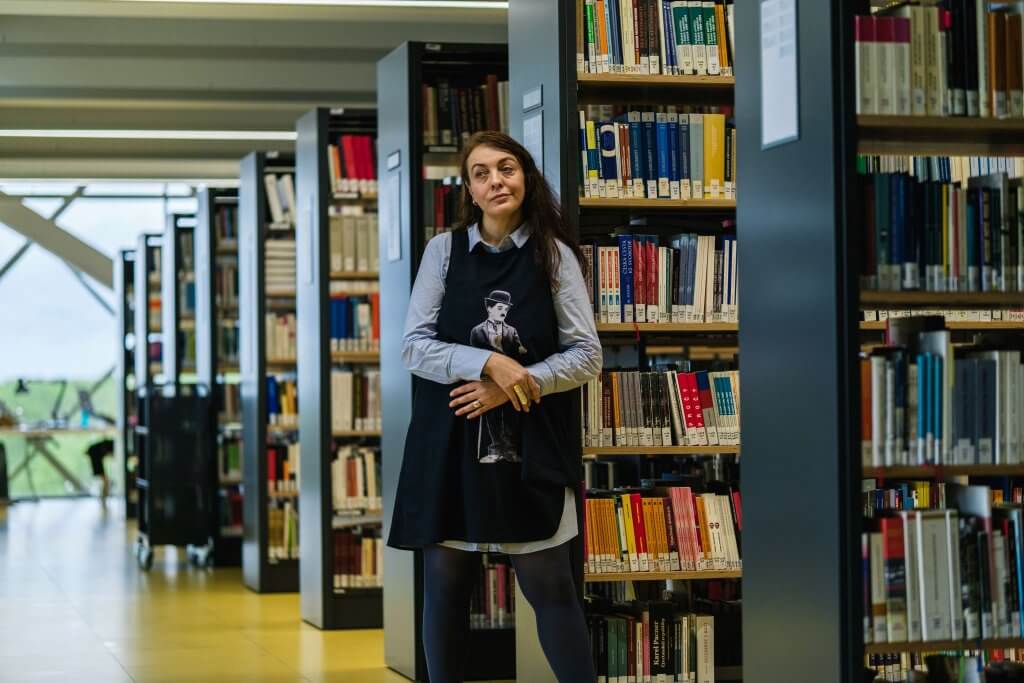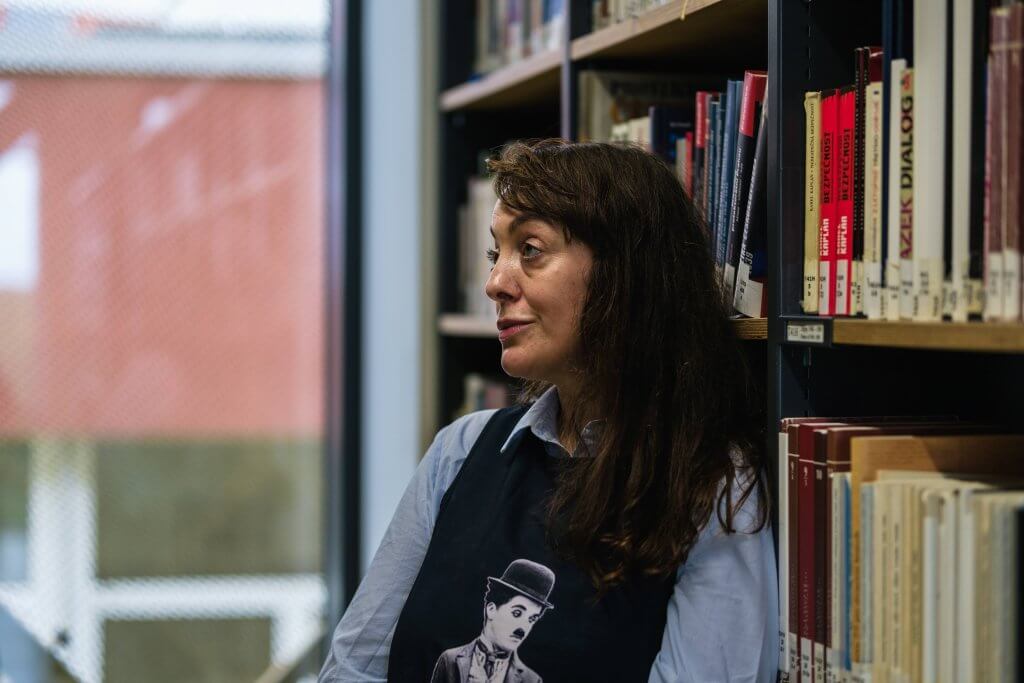From Political Aesthetics to “Flawed Saints”: Maria Alina Asavei Explores How Art, Religion, and Memory Intersect

Assoc. Prof. Maria Alina Asavei, a researcher at the Institute of International Studies at FSV UK, has never shied away from complexity. With academic roots in Romania, scholarly development in Budapest and New York, and teaching experiences across Europe and the Middle East, her career is defined by a pursuit of neglected or “marginal” topics – those lying at the intersection of art, politics, religion, and memory. “Lack of secondary sources doesn’t discourage me – on the contrary, it signals something meaningful waiting to be unpacked,” says Asavei.
She began her study journey at the Alexandru Ioan Cuza University in Iași, a historic Romanian university near the Moldovan border. Continuing her studies abroad, however, was not a decision she took lightly. “Back then my life in Iasi was quite interesting – both professionally and personally. I had an enriching community of artists, philosophers and art theorists around me and a part time job in academia,” recalls Asavei. “However, I always felt that there is more to be done in my fields of interest and the access to books, online databases, and research was quite limited at that time. I recall going to the university’s library almost every day and feeling frustrated about not finding the sources I was looking for,” she adds.
Eventually, she received a scholarship to the Central European University in Budapest, where she completed her second Master’s degree. She recalls that this experience had an immediate and tremendous impact on her. “I learnt in one year more than I had had the chance to learn in four years at my Alma Mater in my country,” points out Asavei. Subsequently she completed a PhD in Aesthetics and Philosophy of Art. Her doctoral thesis, Political-Critical Art and the Aesthetic, laid the theoretical groundwork for her future research, which increasingly leaned toward interdisciplinary inquiry. “While writing my PhD thesis, I knew that my research path would not strictly follow my philosophical formation. However, I focused quite heavily on philosophy of social sciences, hermeneutics, aesthetics, political philosophy and theory,” she says.
Over time, she gradually gained confidence in her academic profile. While she had always been drawn to the humanities and the arts – and had even engaged in literary writing – academic research became an exciting new path for her. “Digging up to find lacunas and unexplored and niche topics has become a modus operandi during my entire academic career. I was interested in ‘marginal’ topics and I aimed at making them mainstream,” she explains.

This perspective has shaped Asavei’s academic trajectory ever since. After CEU, she worked with the City University of New York and held visiting roles at Maastricht University and the American Research Center in Sofia. She also taught summer courses for the Open Society Foundation in Istanbul, Tbilisi, and Amman, finishing her (up to now) academic path at FSV UK. “Each academic tradition offers useful insights to knowledge production. In my case, while analytical tradition (Anglo-Saxon) disciplined and structured my argumentative, critical skills, the continental tradition convinced me of the inseparability of history and philosophy,” she explains.
Art, politics and religion
Her research focuses on the intersection among art, politics and religion from a variety of perspectives – i.e. aesthetics, memory studies, area studies, cultural anthropology, political theology, cultural studies or political theory. Asavei’s work draws on her extensive curatorial experience as well. She frequently organizes exhibitions focused on political art, human rights, and memory, especially from marginalized communities. “As a curator I attempt to either re-enact the social theories I study through artistic production or/and to apply the memory studies/cultural theory lens to cultural production from above (renowned artists) and from below – artistically minded individuals and communities who do not possess the epistemic authority to call themselves as art producers,” she says.
One of the most important turning points in her academic career came through a research grant at Fordham University’s Orthodox Christian Studies Center in 2018–2019. There, she deepened her engagement with religion – not as isolated doctrine, but as a political and aesthetic force. The result was her monograph Art, Religion and Resistance in (Post-)Communist Romania: Nostalgia for Paradise Lost? (Routledge, 2023).
The book addresses a lacuna in the cultural history of post-communist Romania. The main aim was to explore the interconnections between politics and religion through the lens of artistic production and consumption, investigating how art inspired by religion functioned as a form of resistance, directed against both Romanian national communism (1960-1989) and, latterly, consumerist society and its global market (1990-2010). Moreover, the book challenges the assumption that communist Romania wholly suppressed religious expression.

Against this standpoint, Asavei shows how Orthodox motifs and narratives were appropriated and reinterpreted – sometimes co-opted into nationalist propaganda, sometimes used by artists as subtle resistance. She coins the term “godless religion” to describe how spiritual symbols were culturally preserved while emptied of their theological content. Through detailed analysis of artworks, archival documents, and private letters, the book maps how religion, art, and politics intertwined in both oppressive and subversive ways. “This was an attempt to bridge the perceived gap between contemporary art/modernity and religious culture,” she explains.
Populism, Memory, and the “Flawed Saints”
Asavei’s ongoing research continues to blur boundaries. In her article Flawed Sainthood in Popular Culture: Maradona’s Culture of Commemoration in Naples, she introduces the concept of “flawed saints”: figures like Diego Maradona who, though never canonized, are venerated by vernacular communities in quasi-religious ways. Through artefacts, shrines, and graffiti, fans construct a grassroots sainthood that fulfills spiritual and mnemonic needs. “The aim is to offer a fresh conceptual engagement with the contemporary cultural-political phenomenon of “flawed saints” commemoration through the lens of contemporary popular culture, taking the culture of commemoration of Diego Maradona as a case study,” she says.
One of her recent projects for example investigated vernacular family vacation photos from communist Romania – particularly images featuring stuffed animals – as sites of cultural memory and nostalgia. Another traced the underexplored political dimension of textile artefacts, analyzing how their material and immaterial layers express longing for the communist past. “I aim to address the cultural, mnemonic, and emotional geographies of these souvenir family photographs, as well as the narratives about vacationing these photographs elicit when re-discovered,” she points out.
She also recently led the Czech team for the EU Horizon 2020 project Populist Rebellion Against Modernity (POPREBEL), exploring populist rebellion across Central and Eastern Europe. Collaborating with institutions like UCL, the University of Belgrade, and Jagiellonian University, she contributed to a comparative analysis of how societies reckon with modernity, memory, and populist backlash.

What Comes Next?
Still, conducting research abroad hasn’t been without its challenges, particularly due to the language barrier. At the same time, she sees great value in both studying and working in international academic environments. “The major advantage was the immersion into various cultural/academic traditions. Each academic tradition offers useful insights to knowledge production,” she reflects.
What attracted her to the Institute of International Studies (IMS) was above all its research diversity. When offered the opportunity to teach and conduct research on the Balkans and Central Europe, she was pleased – it was the area she knew best. “The collaboration with my colleagues developed gradually and it contributed to the enlargement of my research focus,” she explains.
Looking ahead, Asavei aims to further develop her research at the intersection of political theology, religious studies, and memory/cultural studies. She is particularly interested in how mnemonic communities without official authority create their own commemorative practices – especially around “impure saints” who embody both cultural flaws and spiritual significance.


